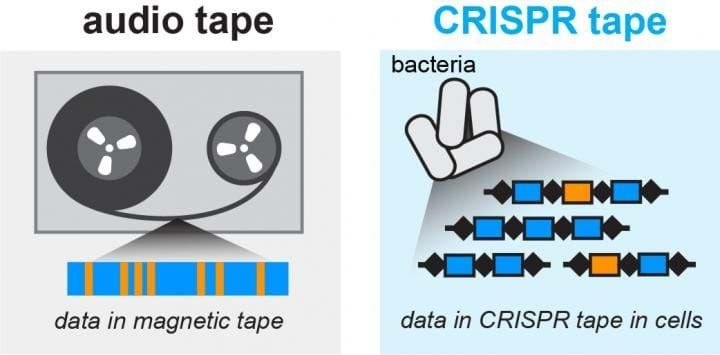A microbial ‘tape recorder’
BACTERIAL cells that work as a “tape recorder”, by recording environmental interactions and time-stamping events, could lead to a new class of technologies, according to researchers.

Made using CRISPR “molecular hacks”, the modified Escherichia coli cells could allow the measurement of biological events over time on a large scale, such as cellular states and environmental changes. Applications of this could include environmental monitoring and disease diagnosis.
In a Science paper, researchers from Columbia University, US, demonstrated that they could record into the DNA of cells over multiple days. They also showed that they could monitor several parameters of interest at once, by recording the availability of three cell metabolites – copper, trehalose, and fucose – simultaneously.
This was possible by taking advantage of CRISPR-Cas, an immune system in many species of bacteria. CRISPR-Cas copies precise snippets of DNA from invading viruses, accumulating a chronological record, so that subsequent generations of bacteria can repel these pathogens more effectively.
“The CRISPR-Cas system is a natural biological memory device,” says assistant professor of pathology, cell and systems biology Harris Wang. “From an engineering perspective that’s actually quite nice, because it’s already a system that has been honed through evolution to be really great at storing information.”
To build their microscopic recorder, the team modified a piece of circular DNA called a plasmid, giving it the ability to copy itself in response to external signals. A separate recording plasmid, which drives the recorder and marks time, expresses components of the CRISPR-Cas system.
In the absence of an external signal, only the recording plasmid is active, and the cell adds ‘blank’ copies of a sequence to the CRISPR area in its DNA. When an external signal is detected by the cell, the other plasmid is also activated, and inserts its sequences instead. The result is a mixture of background sequences that record time, and signal sequences that change depending on the cell’s environment.
The researchers can then examine the the position of the bacterial CRISPR and use computational tools to read the recording and its timing.
“Such bacteria, swallowed by a patient, might be able to record the changes they experience through the whole digestive tract, yielding an unprecedented view of previously inaccessible phenomena,” said Wang.
Synthetic biologists have previously used CRISPR to store poems, books, and images in DNA, but this is the first time CRISPR has been used to record cellular activity and the timing of those events.
Science: http://doi.org/cgmr
Recent Editions
Catch up on the latest news, views and jobs from The Chemical Engineer. Below are the four latest issues. View a wider selection of the archive from within the Magazine section of this site.




